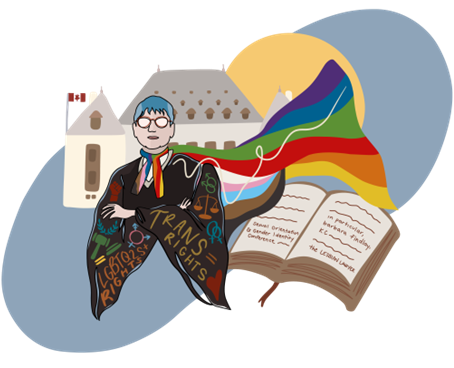
The courtroom is not where one expects to encounter a superhero. Indeed, lawyers, even the great ones, have yet to inspire such a characterization, in fiction or in fact. Until now! barbara findlay[1] KC, as this article will demonstrate, has earned the right to be revered as such. After all, a superhero, simply put, is a human being who uses their unique abilities to make the world a more just and humane place. While your average superhero conceals their identity, barbara is the lawyer who wields her pride in her lesbian identity as a superpower to achieve equal rights and justice for the 2SLGBTQ+ Community.
Illustration by Erika Flores @inkscrpt
Not a “Normal Girl”?
barbara, who describes herself as “a fat old white cisgender queer lawyer with disabilities”, was raised working class and christian on the prairies. After high school, barbara educated herself at Queen’s University, where she pursued a Bachelor of Arts focusing on sociology. However, her true matriculation was in forbidden love and self discovery. In 1968 barbara met and fell in love with a woman - “the single most important thing” that happened in her life. At that time, Pierre Trudeau, the then Attorney General of Canada, had just passed the Criminal Law Amendment Act, 1968–69, an amendment to the Criminal Code of Canada, that partially decriminalized homosexual acts between consenting adults in private[2]. While this amendment was lauded as "bringing the laws of the land up to contemporary society,[3]” same sex attraction was still considered to be a mental illness — The American Psychiatric Association didn’t remove the diagnosis of “homosexuality” from the Diagnostic and Statistical Manual[4] until 1973. Consequently, lesbian love led to barbara’s committal to a psychiatric hospital where her psychiatrist told her that his goal was to “turn her into a normal 18 year old girl” and suggested that she change her clothes to be “more attractive.”
This experience set barbara on a path of self discovery and ultimately self acceptance.
barbara says “I knew there was either something wrong with me, or something wrong with the world. When I figured out there was nothing wrong with me, I knew I had to change the world.”
This was the moment that ignited the activist within barbara.










